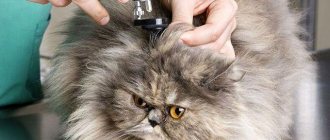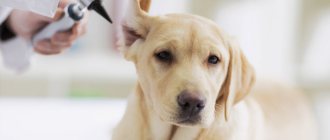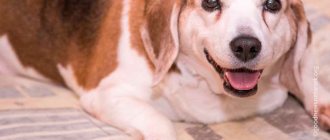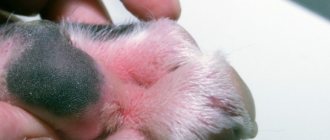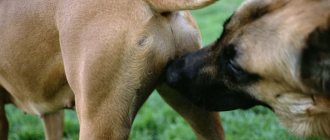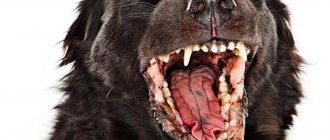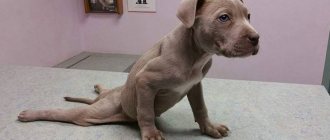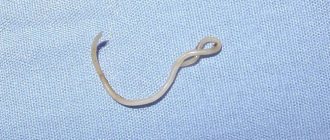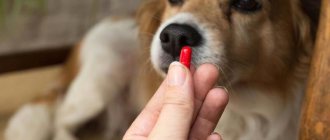How to recognize it?
There are obvious symptoms of allergic otitis in a dog, which help to identify the disease at the earliest stage of its development. These are:
- Visual change in the appearance of the ear. It increases in size, turns red, and the fur partially disappears from it.
- You can try to touch it. A loving owner will immediately determine whether his animal is in pain.
- Normally, with otitis media, yellow, gray or transparent fluid may leak from the ear. You should be wary if bloody discharge is detected.
- The dog's behavior will change noticeably. He will sleep restlessly, constantly scratch his ear, and shake his head frequently. All these signs will show his characteristic malaise.
- Often with such allergy symptoms, body temperature rises.
If the disease is not eliminated in time, the most dangerous symptoms of allergic otitis in a dog will begin to appear. For example, this is enlarged lymph nodes.
What is the difference?
Purulent otitis is an inflammatory disease affecting the outer, middle and inner ear. The deeper the disease penetrates, the more seriously the hearing system suffers, and the risk of partial or complete hearing loss increases.
Develops as a complication of an infectious, fungal or parasitic disease. It differs from other types of pathology in the release of pus with an unpleasant odor. The animal's condition instantly deteriorates, which manifests itself in the form of increased body temperature and vomiting.
The most likely causes of the disease
Allergy is a disease that can occur in every living organism. It does not develop on its own. There must be a “catalyst” present that will give impetus to the development of the reaction. Experts have identified the five most likely causes of allergic otitis media in dogs:
- Genetic factor. If your pet has had females or males in their family who suffer from this disease, then the risk of acquiring it is quite high.
- Poor nutrition and a sedentary lifestyle lead to decreased immunity. The dog’s body relaxes and becomes susceptible to external factors.
- If an animal is in a state of stress for a long time, then all the sores become attached to it like a magnet.
- The “impetus” can be given by past viral or infectious diseases.
- Perhaps a new product was recently added to the dog’s diet or a medication was used that caused such a reaction.
Allergic otitis media in dogs can also develop independently. Veterinarians call this ability an individual characteristic of the body.
Associated symptoms
Many livestock breeders know firsthand how allergic otitis media manifests itself in a dog. They are sure that first of all the shape of the ear should change. It is worth noting that there are several other accompanying symptoms that will help identify the disease at the earliest stages of its development.
With the development of any inflammatory process, the dog develops problems with stool. There is prolonged constipation or frequent diarrhea. Along with them, vomiting and nausea may appear.
The allergen can actively affect the mucous membranes. The owner will definitely notice that his beloved animal is suffering from a profuse runny nose and lacrimation. Continuous sneezing is also a characteristic symptom.
The behavior of the individual will also change dramatically. She will become very irritable and aggressive.
Otitis media in dogs
The cause of otitis media is the penetration of infection from the external auditory canal. It occurs in acute or chronic otitis externa due to a rupture of the eardrum, or less commonly, the infection penetrates from the pharynx through the Eustachian tubes. Otitis of the middle ear in a dog has the following symptoms: pain when pressing at the base of the auricle, hearing impairment, partial paralysis of the facial nerves (the shape of the dog’s muzzle may change), as well as the so-called Horner’s syndrome (drooping of the upper eyelid and narrowing of the pupil of the eye on the part of the patient). ear). This is due to damage to the sympathetic nerves passing through the tympanic cavity. Otitis media in a dog most often occurs due to untimely consultation with a doctor, delaying treatment , as a result, the disease progresses to the stage of chronic purulent external otitis, which sooner or later leads to damage and rupture of the eardrum .
Treatment of otitis media in a dog consists of identifying the pathogen and determining its resistance, thorough sanitation, and the use of antibiotics and glucocorticoids locally and systemically. Therapy can be quite long, up to 6-8 weeks. If during this time the treatment of otitis media does not bring positive results for the dog , an operation should be considered, during which the doctor will open the tympanic cavity, remove pus and dead tissue, rinse the cavity with an antiseptic and install drainage. Treatment of otitis media in dogs should only be carried out under medical supervision. Neglected cases or self-medication can lead to hearing loss in the animal, and, as we said earlier, to the transfer of infection from the middle to the inner ear, which, in turn, can lead to meningitis, encephalitis and death.
Internal otitis in dogs is the most severe form of otitis. It occurs when an infection affects the inner ear. As a result, deafness occurs; the dog also loses its understanding of the position of its body in space. A sick animal develops a tilt of its head towards the diseased ear, lack of coordination, a sharp rise in temperature, and the animal refuses to eat. These symptoms threaten the animal's life due to the high probability of infection entering the dog's brain. If you notice such signs in your pet, this is a reason to urgently, within the next few hours, take him to the doctor. Only timely assistance, the administration of very strong antibiotics and corticosteroid drugs intravenously, as well as drainage of the purulent cavity can save lives in this case. Treatment of such an animal is possible only in a hospital.
First aid for an animal
Unfortunately, not all people have the opportunity to immediately bring an animal to a veterinary clinic. This is due to the lack of free time, an appropriate vehicle and a low financial level. There are several steps you should follow to alleviate your dog's condition.
- You should think carefully about your dog's pastime over the past 24 hours. You need to try to identify the cause of the allergy and eliminate it.
- It is necessary to give her any antihistamine that blocks the manifestation of the irritating factor.
- The pet should be switched to a gentle diet.
It is recommended to examine your animal every hour. If his condition continues to worsen, then a trip to an experienced specialist will be necessary.
Most susceptible animals
The following groups are most predisposed to developing ear diseases:
- Breeds with floppy ears (cockers, dachshunds, poodles). The cause of otitis media is inaccessibility to ventilation.
- Shepherd dogs. Their hearing organ does not have a protective barrier from dust, dirt and germs.
- Breeds with folded faces (Shar Peis, Pugs).
Pets living in humid climates or who like to swim are also susceptible to ear infections.
Treatment with medications
Treatment of the animal is carried out strictly with the medications prescribed by the specialist. You should not self-medicate, as there is a high probability of causing serious harm to your animal. After diagnosis and laboratory testing, the following medications may be prescribed:
- “Bars” and “Rosinka” are two universal remedies that will relieve an allergy attack at the earliest stages of its development. They should always be present in the first aid kit of owners of susceptible animals.
- If severe swelling occurs, then only a drug with anti-inflammatory properties can relieve it. The ideal option for such a case is Dekta drops for allergic otitis media in dogs.
- During an allergic reaction, dogs experience severe, almost unbearable itching. Only antihistamines will help relieve it. “Otodepin” has proven itself to be excellent. It guarantees excellent results, while having a minimum of side effects and contraindications.
The course of treatment for allergic otitis media in dogs must include Surolan drops. They will relieve not only the allergic reaction, but also severe swelling.
Medical care provided by a veterinarian
Treatment of otitis media is a complex process aimed at getting rid of itching and pain, finding the cause and eliminating it, and overall improvement of the body.
Treatment principle
Treatment of otitis consists of several stages:
- Strengthening immunity;
- Relief from pain and itching;
- Determining and eliminating the cause of otitis media;
- Removal of pus and other secretions;
- Cleansing of pathogenic organisms not only in the disturbing place, but throughout the entire body;
- Cleansing the body of decay products of bacteria, fungi and other organisms during long-term treatment of otitis media.
Subsequence
The procedure for providing assistance to a veterinarian:
- Cleaning the ears from dirt, wax, crusts using a cotton pad and hydrogen peroxide;
- Cleansing the ear canal with a cotton pad and chlorhexidine. First, medications are dripped into the ears to soften them. Soaked crusts and other dirt are cleaned and collected for microscopy and bacterial culture in order to determine the causes of otitis media and prescribe effective treatment;
- Using a solution of brilliant green, bleeding wounds are treated;
- If there are deep wounds, then wound-healing drugs and antiseptic ointments are used;
- After cleaning the ears, drops are prescribed depending on the nature of the disease. If the diagnosis is difficult to determine, then general purpose drops are recommended, aimed at combating fungi, mites and pathogens;
- Purulent otitis media in a dog is necessarily accompanied by a course of antibiotics lasting 5–7 days;
- In case of severe otitis, accompanied by general intoxication of the body, droppers are prescribed;
- Immunostimulating drugs are prescribed regardless of the severity of the disease.
List of medications for otitis media
The following medications are most often used in medicine for otitis media:
- Hygienic ear cleaning – Otifri, Epi – Opik, Otoklin. All instructions are included, the easiest to use will be Epi-Opik, but its price is comparatively higher, about 850 rubles. Other products fill the ear canal, massage and gently remove with a cotton pad;
- Antiseptic ear cleaning – hydrogen peroxide 3%, chlorhexidine 0.05%, salicyl – tannin alcohol 2%, brilliant green solution is used for wounds;
- Wound healing ointments and antiseptics – Levomekol, Safroderm, Sanatol;
- Drops for otitis media of combined action are aimed at treating fungi, microbes and parasites - Oritsin, Tresaderm, Otospectrin, Surolan;
- Drops with anti-inflammatory effect - Otinum, Otipax;
- Drops to combat microbes - Sofradex, Anandin, Otibiovet, Fugentin, Tsipromed;
- Drops to combat fungi - Nitrofungin, Clotrimazole, Terbinafine;
- Drops to combat ticks - Dekta, Bars, Amitrazine, Rolf Club, Otoferonol Gold;
- Immunostimulating drugs – Cycloferon, Immunofan, Ligfol;
- Antibiotics for otitis in dogs - Amoxicillin in combination with clavulanic acid, Ceftriaxone.
How to use ear drops correctly?
Treatment of allergic otitis in dogs is a very responsible process. A positive effect will be achieved only if the procedure was carried out correctly. Before using it, you need to wash your hands thoroughly with soap. It is recommended to additionally treat your hands with a disinfectant or wear sterile gloves.
You must first remove wax and crusts from the surface of the animal’s ear with a cotton swab. This must be done extremely carefully so as not to injure the dog. It should not be inserted deeply, so as not to damage the eardrum.
The container in which the drops are stored must be held in a closed palm for several minutes so that the liquid warms up to room temperature.
A drop of medicine should accurately fall into the auricle. To do this, your pet's ear should be pulled back a little. After completing the procedure, massage the upper part of the skin until the drops are completely absorbed.
Diagnostics
You cannot be treated for any disease without an accurate diagnosis. Many pet owners are confident that they will be able to spot otitis media and prescribe treatment for their pet based on their knowledge. The fact is that this pathology cannot be seen with the naked eye. Therefore, the presence of the disease can be assumed only based on the clinical picture.
To confirm or refute the diagnosis, a sample taken by a veterinarian from the dog's ear is examined. Additional diagnostic measures may be prescribed at the discretion of the doctor.
What absolutely cannot be done?
An animal is a weak creature that can be easily harmed. There are a huge number of mistakes that owners make. Of these, the five most popular can be identified:
- Veterinarians categorically prohibit self-medication, even if the caring owner thinks that he has already encountered such a disease. It is impossible to independently diagnose an animal without examination by a specialist. Arbitrary medical measures can only aggravate the situation.
- You should not treat the ears with any sharp instruments, as this may cause injury to your pet.
- Before handling ear drops for dogs, be sure to wash your hands. Otherwise, the risk of infection and bacteria will increase.
- You should not carry out the procedure with low-quality ear sticks. Residues of cotton can penetrate into the auricle and begin to decompose in it.
- Many owners commit a serious violation - they begin to try to treat the ear with hydrogen peroxide. Dogs have a very negative attitude towards this procedure. If there was pus in this area, it will begin to actively foam, causing a ringing sound. The animal's behavior will become extremely aggressive.
- If a person does not have special education, then he absolutely should not treat the dog himself in order to save money on going to a qualified clinic. Drops for allergic otitis in dogs and other medications should be prescribed by a veterinarian after examining the animal and, if necessary, taking tests. You shouldn’t skimp on the health of your beloved pet.
First aid
If you suspect a disease, you should immediately contact a veterinarian. Self-selected medications can worsen the dog’s condition, aggravate the inflammatory process and cause irritation. Only a veterinarian can correctly determine the form and describe the treatment regimen.
Under no circumstances should you put hydrogen peroxide in your dog's sore ear. Reacting with pus and bleeding wounds, the peroxide begins to fizz and foam strongly. This will make a lot of noise and scare the dog. Peroxide can only be used on the outside of the ears.
There is no need to try to clean the sore ear with cotton swabs. They cannot remove accumulations of pus, and pieces of cotton wool may remain inside. Veterinarians clean the ear canals using a handy clamp or tweezers that securely hold a cotton swab.
If you have never cleared discharge from your pet’s ears, then your actions can cause him severe pain, including seizures. By doing this, you will aggravate the dog’s condition, and it will resist further actions.
Simple procedures will alleviate the animal’s condition before visiting the doctor:
- carefully examine the ear without foreign objects;
- treat the outer part with hydrogen peroxide, cauterize the wounds and scratches with brilliant green;
- instill 3-4 drops of Otinum or Otipax to relieve pain;
- after soaking the discharge and numbing it, clean the ears with a cotton swab wrapped around tweezers, only if you have previously cleaned the dog’s ears;
- if you have never done cleaning before, remove only visible dirt from the outside; a veterinarian will do a deep cleaning;
- if there is pus in the ear, add a mixture of streptocide and boric acid powders (ratio 1:5);
- if the dog has an elevated body temperature, you can give Analgin once as an antipyretic and analgesic - 0.5 tablets/10 kg orally.
How to distinguish allergic otitis media from its other manifestations?
The appearance of any kind of inflammation does not always indicate the presence of allergic otitis media in dogs. There are several other manifestations of this disease:
- Purulent otitis media appears due to penetration of a foreign body or infection into the ear. A characteristic symptom is an unpleasant sour smell from this area. First, a small compaction forms, which is easy to detect visually. After a few days, pus will begin to actively flow out of it. Ear drops for dogs will not be enough here. Additional antibiotics will be required. If a foreign body gets into the area of the auricle, you will have to resort to surgical intervention.
- The occurrence of fungal otitis is provoked by various fungi. This is one of the most common diseases among animals. It is treated only by wiping with a solution of phosphoric acid.
- Seasonal otitis media appears during certain periods due to the high production of sulfur. After which the surface of the auricle becomes covered with crusts, plugs appear, which cause discomfort in the dog. Only a course of antibiotics can help such a patient.
Every person who decides to have such a pet should know how to distinguish allergies from other possible diseases. When the reaction actively develops, the most gentle diet and rest regime, proper hygiene and coat care should be selected for the animal.
In addition, it is worth noting that allergic otitis media in dogs is the most dangerous manifestation of this disease. The body can behave completely unpredictably during such a reaction. There are several signs characteristic of this particular type of disease: severe itching, irritation and redness.
Symptoms
The following symptoms help determine the presence of purulent otitis media:
- redness, swelling of the ear;
- hearing impairment;
- discharge of pus from the ear with an unpleasant odor;
- increased body temperature;
- vomit;
- the pet touches a sore spot, tilts its head, does not tolerate having its ear touched;
- decreased appetite;
- lethargy;
- impaired coordination of movements.
The pet lies down a lot, refuses to eat, and whines. The affected ear begins to droop and the lower jaw becomes displaced. In severe cases, nausea, vomiting, and convulsions occur.
Preventive measures
How to treat allergic otitis in a dog? Almost every caring livestock breeder has had to ask a similar question. Basically, this disease progressed if the owner did not comply with preventive measures in a timely manner. There are several ways to reduce the risk of its development:
- It is recommended to periodically trim your pet's hair, affecting the area around the ears. In medicine, this process has acquired the term ventilation of the ear canal. You should not do this yourself; it is better to contact an experienced specialist.
- Many livestock breeders wash their dog's ears after every walk. This is strictly forbidden. With regular such procedures, healthy microflora is disrupted, which leads to the risk of disease.
- Water should not get into the auricle. If penetration does occur, the liquid must be carefully removed from the cavity with a cotton swab.
- You should avoid walking in strong winds.
- Do not allow the animal to get injured.
Once every six months it is worth taking your pet to the veterinarian for an examination of the ears. This will allow the disease to be identified at the earliest stage of its development. If necessary, the doctor will advise how to treat allergic otitis in a dog.
Other symptoms of otitis media
When the first signs appear, you need to carefully monitor the condition and behavior of your pet. Fungus in dogs manifests itself with the following symptoms:
- pus and bloody streaks in the ears;
- specific odor emanating from the affected area;
- redness of the skin in the inner part of the ear;
- if the disease is advanced, inflammation of the submandibular lymph nodes may occur;
- visible discomfort of the pet when yawning;
- hearing problems in dogs;
- pet's refusal to eat solid food;
- plaque on the eyeballs and discharge from the eyes;
- in advanced cases, meningitis and problems with the vestibular apparatus.
If any of these symptoms occur, take your pet to the doctor immediately. Otitis is treated with medication. The doctor will prescribe the appropriate medications for your pet. You should not select medications on your own, as this can lead to complications.
Good advice
A sick pet needs to create favorable conditions for a speedy full recovery. You shouldn’t force him to play or go for walks again. He needs good sleep. If a dog has allergic otitis, he needs a diet. It is worth filling his diet with natural foods high in protein. It is imperative to give your dog a sufficient amount of fluid per day. If you wish, you can ask your veterinarian to prescribe a course of vitamins that strengthen the immune system. If an animal suffers from allergies frequently (more than five times a year), then it is prescribed preventive treatment to block the allergic reaction. Typically, such events are divided into several courses, each of which lasts from 7 to 15 days.
Does your dog have allergic otitis media? What to do in such a situation? First of all, don't panic! This disease is quite easy to cure if you contact an experienced specialist in a timely manner and begin the correct treatment!
Symptoms
Symptoms of allergic otitis media include:
- Constant itching. The dog scratches its ears, causing wounds and scratches to appear - this is a favorable environment for parasites, so you need to quickly eliminate the disease.
- Unpleasant smell. There is no discharge, unlike purulent otitis, when pus periodically emerges from the wounds.
- Anxiety. The pet behaves unusually: shakes its head, runs from room to room, cannot find a place for itself, sleeps poorly, etc. Anxiety is characteristic of all types of otitis, including allergic ones.
- The animal often tilts its head to one side. This is a sign that it is the tilted ear that is causing him discomfort.
- The pet does not allow his ears to be touched. He may squeal, growl, or even try to bite someone who wants to look or touch the ears.
- Increased temperature in the affected area of the body. When you touch the ear, you will feel that it has become noticeably hotter than the rest of the dog's skin.
- Loss of appetite. The dog loses interest in everything that happens, including food. The thirst persists.
- Severe redness and swelling of the inside of the ears. Characteristic exclusively for allergic otitis media.
The table will help you figure out what kind of otitis media your pet has:
| Type of otitis | Signs |
| Purulent | With purulent otitis media, the ear looks moist (oily discharge) and emits a strong odor |
| Allergic | There is redness, severe swelling, and an unpleasant odor (not pungent) |
| Fungal | Fungal otitis is characterized by suppuration, crusts and cracks on the skin |
| Verrucous | Upon examination, you can notice numerous growths (in the auricle and near the ear canal) and slight redness. |
| Bacterial | There are crusts and blood clots |
| Seasonal | Crusts appear (due to excessive release of sulfur), and hearing may deteriorate due to the presence of plugs |

